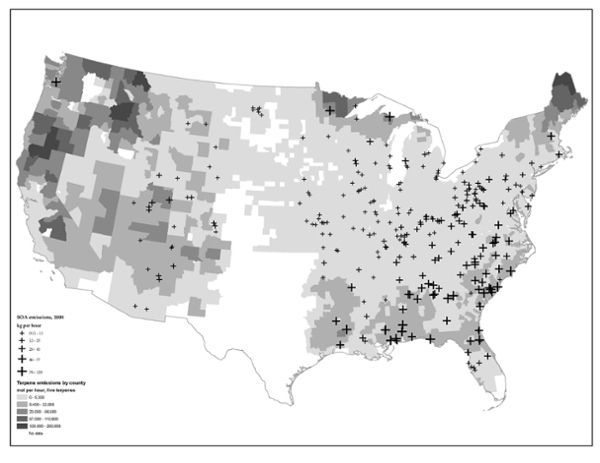
IRIS login | Reed College home Volume 96, No. 2: June 2017
Researchers clear the air on power plant emissions

The Reed team compared SOA emissions (crosses) with terpene emissions (shaded areas) to gain a better understanding of the impact of power plants on air quality,
Government regulators are not measuring the full effect of power plants on air quality, according to a team of Reed researchers, because they fail to account for the interaction of power-plant emissions with natural emissions from a surprising source—trees.
In some cases, the impact of these so-called “secondary organic aerosols” is almost twice as strong as the pollution that is currently measured at the smokestack, calling into question the adequacy of conventional methods for measuring air quality.
The study by Prof. Julie Fry [chemistry and environmental studies], Prof. Chrs Koski [political science and environmental studies], Kristin Bott [Instructional Technology Services], Marisa Hazell ’15, and Raphaela Hsu-Flanders ’16, published in the June 2015 issue of Environmental Science & Policy, shows that the impact of trees on air pollution is much more complicated than you might think.
Their study set out to better understand how monoterpenes, organic compounds naturally produced by trees that can help generate clouds and cool the climate, interact with the gasses produced from power plants.
Currently, the Environmental Protection Agency regulates according to the Clean Air Act, focusing on the on-the-ground sources of particulate matter production. However this does not fully grasp all the chemical interactions that happen once the pollution enters the atmosphere. As the Reed researchers point out, gasses such as NOx and SO2 combine with monoterpenes from trees to produce secondary organic aerosols (SOAs)—microscopic airborne particles that can cause significant human health problems and influence regional climate.
Combining data sets concerning emissions data of nitric oxides and monoterpene with laboratory yield measurements of the chemical reaction of the compounds, the researchers show that power plants generate particulate matter not only at the smokestack, but also downwind in in the form of SOAs, particularly when power plants are located near certain types of forests.
The findings imply that pollution can be more effectively regulated by considering the future location of power plants combined with attention to reasonable limits on NOx production. By understanding how this oxidation works, power plants can better control how much particulate matter is generated in the atmosphere. Essentially, by measuring the distribution of certain types of trees and their proximity to power plants and roads, state and federal regulators can work towards improving ambient air quality.
The paper is the first to be published by an interdisciplinary team of professors and students in Reed’s multidisciplinary environmental studies program, which graduated its first seniors in 2013.
Tags: environmental studies, science, chemistry, undergrad research


LATEST COMMENTS
steve-jobs-1976 I knew Steve Jobs when he was on the second floor of Quincy. (Fall...
Utnapishtim - 2 weeks ago
Prof. Mason Drukman [political science 1964–70] This is gold, pure gold. God bless, Prof. Drukman.
puredog - 1 month ago
virginia-davis-1965 Such a good friend & compatriot in the day of Satyricon...
czarchasm - 4 months ago
John Peara Baba 1990 John died of a broken heart from losing his mom and then his...
kodachrome - 7 months ago
Carol Sawyer 1962 Who wrote this obit? I'm writing something about Carol Sawyer...
MsLaurie Pepper - 8 months ago
William W. Wissman MAT 1969 ...and THREE sisters. Sabra, the oldest, Mary, the middle, and...
riclf - 10 months ago